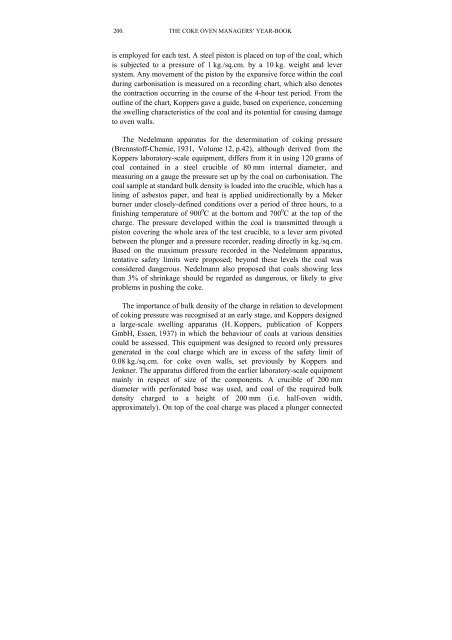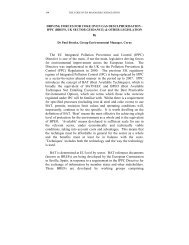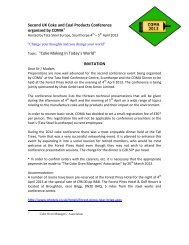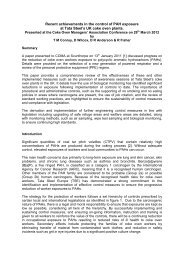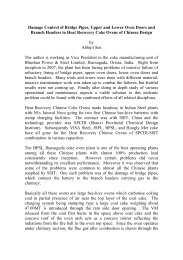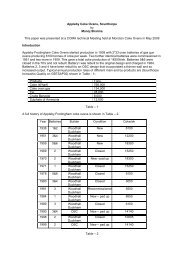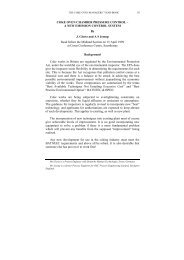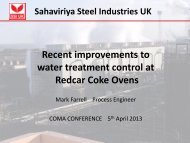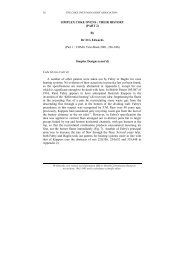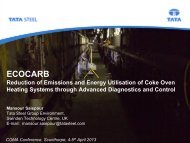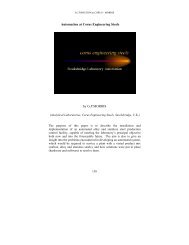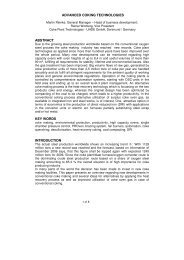CHAIRMAN'S ADDRESS - Coke Oven Managers Association
CHAIRMAN'S ADDRESS - Coke Oven Managers Association
CHAIRMAN'S ADDRESS - Coke Oven Managers Association
- No tags were found...
Create successful ePaper yourself
Turn your PDF publications into a flip-book with our unique Google optimized e-Paper software.
200. THE COKE OVEN MANAGERS’ YEAR-BOOKis employed for each test. A steel piston is placed on top of the coal, whichis subjected to a pressure of 1 kg./sq.cm. by a 10 kg. weight and leversystem. Any movement of the piston by the expansive force within the coalduring carbonisation is measured on a recording chart, which also denotesthe contraction occurring in the course of the 4-hour test period. From theoutline of the chart, Koppers gave a guide, based on experience, concerningthe swelling characteristics of the coal and its potential for causing damageto oven walls.The Nedelmann apparatus for the determination of coking pressure(Brennstoff-Chemie, 1931, Volume 12, p.42), although derived from theKoppers laboratory-scale equipment, differs from it in using 120 grams ofcoal contained in a steel crucible of 80 mm internal diameter, andmeasuring on a gauge the pressure set up by the coal on carbonisation. Thecoal sample at standard bulk density is loaded into the crucible, which has alining of asbestos paper, and heat is applied unidirectionally by a Mekerburner under closely-defined conditions over a period of three hours, to afinishing temperature of 900 0 C at the bottom and 700 0 C at the top of thecharge. The pressure developed within the coal is transmitted through apiston covering the whole area of the test crucible, to a lever arm pivotedbetween the plunger and a pressure recorder, reading directly in kg./sq.cm.Based on the maximum pressure recorded in the Nedelmann apparatus,tentative safety limits were proposed; beyond these levels the coal wasconsidered dangerous. Nedelmann also proposed that coals showing lessthan 3% of shrinkage should be regarded as dangerous, or likely to giveproblems in pushing the coke.The importance of bulk density of the charge in relation to developmentof coking pressure was recognised at an early stage, and Koppers designeda large-scale swelling apparatus (H. Koppers, publication of KoppersGmbH, Essen, 1937) in which the behaviour of coals at various densitiescould be assessed. This equipment was designed to record only pressuresgenerated in the coal charge which are in excess of the safety limit of0.08 kg./sq.cm. for coke oven walls, set previously by Koppers andJenkner. The apparatus differed from the earlier laboratory-scale equipmentmainly in respect of size of the components. A crucible of 200 mmdiameter with perforated base was used, and coal of the required bulkdensity charged to a height of 200 mm (i.e. half-oven width,approximately). On top of the coal charge was placed a plunger connected


